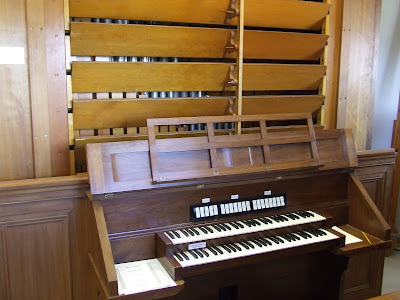Things that were still wrong with my organ before Memorial Day:
- Swell Pedal doesn't work
- Electrical popping sounds in the pedal keys (when amplified)
- Loud electrical cracking sounds in the Low F and F# of the pedal keys
- Diaopason reeds sound, but not through the amplifier
- 1 note from each of the Flute, Viola, and Diaopason reeds do not sound at all
After the Memorial Day weekend, I have gotten rid of both of the pedalboard problems, and got the Diaopasons working. So all I need to do is figure out how to get the Swell pedal to work and to fix the 3 notes. But those will be problems for a future date.
The pedalboard problems were easy to fix. I gave the contact switches a very good cleaning and now there are no minor popping sounds anymore. The really loud cracks on the low F and F# was repaired by an earlier technician by wrapping electrical tape around the contact switch. They had fallen off over the years, so I replaced them.
The Diaopasons were trickier because I really did not know what was wrong with them. I knew that the reeds were physically sounding in the organ (you can actually hear the reeds vibrate in these old organs), but the amplified sound was not getting past the pre-amp on the organ. I thought it might be an old wax paper capacitor that these organs had back in 1945. I saw some of them in the back of the organ and I just knew that that was the problem. However, when I took a closer look at the wax paper capacitor I saw that it's electrical leads were cut and that a newer capacitor was routed around the old wax paper one. I checked all the capacitors and resistors that I could see and they had all been replaced. I went back and looked at the schematics of the electrical system (which was tricky because I don't know much about electrical schematics) I figured out where all the wires were going and which wire did what job.
Eventually I traced the wiring from the electrical pickups (little microphones detecting the reeds vibrations) and traced their signals all the way to the pre amp. It was at the pre amp that I found all the signals from all the reeds fed into the pre amp through one single 5 pin plug. Each of the pins of the plug carried the signal of a different rank of reeds: Pedal, Flutes, Violas, Celeste, and Diaopasans. I physically touched the plug and noticed that it was loose. So I unplugged it and noticed that the pin assembly in the plug was loose from the rest of the plug. I pushed it back together, plugged it back into the pre amp, and all of a sudden the Diaopasons were working!!! It was all because of a loose plug. Thank goodness I had not started cutting capacitors out of the back of the organ!!!!!
It is really nice having another entire rank of reeds to play with. I am experimenting with different stop combinations to make different sounds. Soon I will have a new video up on YouTube with the sounds of all the different stops of my organ and some of their combinations. It was a good Memorial Day weekend!!
 The organ console located underneath the swell shade.
The organ console located underneath the swell shade. The organ console with stoptabs. Here is the stoplist:
The organ console with stoptabs. Here is the stoplist: The plaque on the side of the organ where I got this information.
The plaque on the side of the organ where I got this information.
